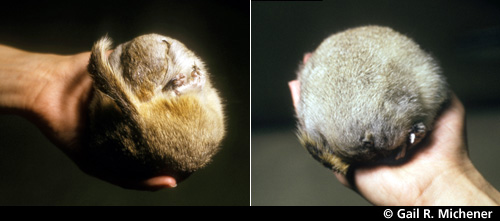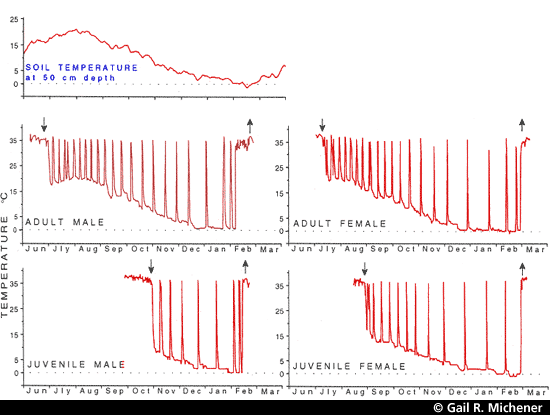Richardson’s ground squirrels, also commonly called gophers, hibernate for 4-9 months of the year, depending on age and sex. Adult Richardson’s ground squirrels hibernate for 7-9 months, juvenile females for 6-7 months, and juvenile males for 4-5 months of the year. Each animal hibernates underground in isolation in its own hibernaculum.
Richardson’s ground squirrels spend 85-92% of hibernation in the physiological state of torpor. During torpor, body temperature is approximately the same as the temperature of the surrounding soil, and heart rate, respiration, and metabolism slow dramatically, allowing the ground squirrel to conserve energy. Because they cannot respond to danger or defend themselves, torpid animals are extremely vulnerable. To minimize risks of predation, Richardson’s ground squirrels inter themselves in the hibernaculum and must dig a new exit to the surface in spring. See Burrow System

When Richardson’s ground squirrels are in the physiological state of torpor their body is rolled into a ball with the head tucked between the hind legs and the tail wrapped over the crown.
Torpor bouts last about 4-6 days in July and August, then steadily become longer as soil temperature declines. In early January, Richardson’s ground squirrels spend 20-25 consecutive days in torpor, with body temperature dropping as low as 0°C. Torpor bouts are interrupted by brief periods of re-warming to the normal mammalian body temperature of 37°C. These arousals last less than 24 hours and consist of a 2- to 3-hour period of re-warming, followed by 12-15 hours when the animal is warm but mostly inactive. Body temperature then slowly cools back down to ambient soil temperature and the squirrel enters another torpor bout. As a general trend, the colder the soil, the colder the animal and the longer the torpor bout.

Body temperature during hibernation based on twice-daily radio-telemetric records. Arrows indicate the day on which the ground squirrel entered the hibernaculum and the day it emerged from the hibernaculum. Body temperature in each torpor bout approximates that of soil temperature at the depth of the hibernaculum (about 50 cm deep).
Source: Michener (1998)
During hibernation, squirrels metabolize fat reserves that were built up during the previous active season. The majority of this fat is used during inter-torpor arousals when the squirrel rapidly warms up and stays warm for several hours while still in the cold soil. Thus, arousals are metabolically expensive. Numerous theories have been proposed for why hibernators such as ground squirrels and marmots arouse numerous times during hibernation.
Adult ground squirrels tend to lose more mass during hibernation than juveniles, and juvenile females lose more mass than juvenile males. This pattern corresponds to duration of hibernation, with adults hibernating longer than juveniles, and juvenile females hibernating longer than juvenile males.
The time of emergence in spring tends to be correlated with periods when surface and air temperatures start to regularly stay above freezing, but soil temperature at the level of the hibernaculum is still near 0°C. Males often terminate torpor a week before they appear above ground, whereas females terminate torpor the day before they appear above ground. Only those males with a food cache in the hibernaculum can afford the energetic expense of staying warm while sequestered in a cold hibernaculum. Regardless of whether they have food stores or not, males come out of hibernation and resume above-ground activity about 2 weeks before females. During the period before females appear, males undergo testicular recrudescence and build up fat reserves in preparation for the mating season.
Related Pages:
Burrow System
Annual Activity Cycle
Sources:
PDFs of many of these articles can be downloaded from the Michener Publications page
- Goodwin, H. T., G. R. Michener, D. Gonzalez, and C. E. Rinaldi. 2005. Hibernation is recorded in lower incisors of Recent and fossil ground squirrels (Spermophilus). Journal of Mammalogy, 86: 323-332.
- Michener, G. R. 2002. Seasonal use of subterranean sleep and hibernation sites by adult female Richardson’s ground squirrels. Journal of Mammalogy, 83: 999-1012.
- Michener, G. R. 1992. Sexual differences in over-winter torpor patterns of Richardson’s ground squirrels in natural hibernacula. Oecologia, 89:397-406.
By other authors:
- Charge, T. D. 2001. Hibernation biology of Richardson’s ground squirrels: Energy utilization and hibernaculum systems. M.Sc. thesis, University of Lethbridge, Lethbridge, Canada. http://hdl.handle.net/10133/151
